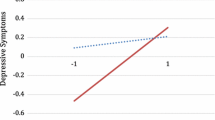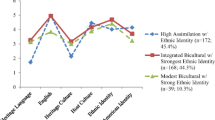Abstract
Theories of acculturation predict that discrepancies in cultural orientation between adolescents and their parents will increase the adolescents’ risk for behavior problems such as substance use. This study evaluated this hypothesis in a sample of 1772 Hispanic 9th grade students in Southern California. Parent–child discrepancy in U.S. orientation (defined as the difference between the child’s U.S. orientation and the child’s perception of the parents’ U.S. orientation) was a risk factor for past-month smoking, lifetime and past-month alcohol use, and lifetime and past-month marijuana use. Parent–child discrepancy in Hispanic orientation (defined as the difference between the child’s Hispanic orientation and the child’s perception of the parents’ Hispanic orientation) was a risk factor for lifetime and past-month alcohol and marijuana use. The adolescents’ own Hispanic orientation was protective against lifetime and past-month smoking and marijuana use, but not alcohol use. In an analysis of mediation, U.S. acculturation discrepancy was associated with lower levels of family cohesion, which in turn was associated with higher levels of substance use. Results suggest that family-based interventions for acculturating and bicultural Hispanic families may be useful in decreasing the likelihood of substance use among Hispanic adolescents.

Similar content being viewed by others
References
Ramirez RR, de la Cruz GP. The Hispanic population in the United States: March 2002, current population reports, P20-545. Washington: U.S. Census Bureau; 2002.
Brook JS, Whiteman M, Balka EB, Win PT, Gursen MD. Drug use among Puerto Ricans: ethnic identity as a protective factor. Hisp J Behav Sci 1998;20:241–54.
De La Rosa M. Acculturation and Latino adolescents’ substance use: a research agenda for the future. Subst Use Misuse 2002;37:429–56.
Epstein JA, Botvin GJ, Diaz T. Linguistic acculturation associated with higher marijuana and polydrug use among Hispanic adolescents. Subst Use Misuse 2001;36:477–99.
Love AS, Yin Z, Codina E, Zapata JT. Ethnic identity and risky health behaviors in school-age Mexican-American children. Psychol Rep 2006;98:735–44.
McQueen A, Getz JG, Bray JH. Acculturation, substance use, and deviant behavior: examining separation and family conflict as mediators. Child Dev 2003;74:1737–50.
Unger JB, Cruz TB, Rohrbach LA, Ribisl KM, Baezconde-Garbanati L, Chen X, Trinidad DR, Johnson CA. English language use as a risk factor for smoking initiation among Hispanic and Asian American adolescents: evidence for mediation by tobacco-related beliefs and social norms. Health Psychol 2000;19:403–10.
Franzini L, Ribble JC, Keddie AM Understanding the Hispanic paradox. In: La Veist TA, editor. Race, ethnicity and health: a public health reader. San Francisco: Jossey-Bass; 2002. pp. 280–310.
Marin G, Marin BV. Research with Hispanic populations. Thousand Oaks: Sage; 1991.
Balcazar H, Castro F, Krull JL. Cancer risk reduction in Mexican American women. The role of acculturation, education and health risk factors. Health Educ Q 1995;22:61–84.
Szapocznik J, Scopetta MA, Kurtines WM, Aranalde MA. Theory and measurement of acculturation. Interam J Psychol 1978;12:113–30.
Portes A, Rumbaut RG. Legacies. The story of the immigrant second generation. Berkeley: University Press of California, Sage; 2001.
Samaniego RY, Gonzales NA. Multiple mediators of the effects of acculturation status on delinquency for Mexican American adolescents. Am J Community Psychol 1999;27:189–210.
Szapocznik J, Rio AT, Perez-Vidal A, Kurtines W. Bicultural effectiveness training (BET): an experimental test of an intervention modality for families experiencing intergenerational/intercultural contact. Hisp J Behav Sci 1986;8:303–30.
Habenstein RW. The then and now overview of the immigrant family in America. In: Mindel CH, Habenstein RW, Wright R Jr, editors. Ethnic families in America: patterns and variations. 4th ed. Prentice Hall: Englewood Cliffs; 1998. pp. 13–38.
Felix-Ortiz M, Fernandez A, Newcomb MD. The role of intergenerational discrepancy of cultural orientation in drug use among Latina adolescents. Subst Use Misuse 1998;33:967–94.
Elder JP, Broyles SL, Brennan JJ, Zuniga de Nuncio ML, Nader PR. Acculturation, parent–child acculturation differential, and chronic disease risk factors in a Mexican-American population. J Immigr Health 2005;7:1–9.
Pasch LA, Deardorff J, Tschann JM, Flores E, Penilla C, Pantoja P. Acculturation, parent–adolescent conflict, and adolescent adjustment in Mexican American families. Fam Process 2006;45:75–86.
Lau AS, McCabe KM, Yeh M, Garland AF, Wood PA, Hough RL. The acculturation gap-distress hypothesis among high-risk Mexican American families. J Fam Psychol 2005;19:367–75.
Szapocznik J, Kurtines W. Family psychology and cultural diversity: opportunities for theory, research, and application. Am Psychol 1993;48:400–7.
Cuellar I, Arnold B, Maldonado R. Acculturation Rating Scale for Mexican Americans-II: A revision of the original ARSMA Scale. Hisp J Behav Sci, 1995;17(3):275–304.
Bauman S. The Reliability and Validity of the Brief Acculturation Rating Scale for Mexican Americans-II for Children and Adolescents. Hisp J Behav Sci, 2005;27(4):426–441.
Olson DH, Portner J, Bell RQ. FACES II: family adaptability and cohesion evaluation scales. Minnesota: Family Social Science, University of Minnesota; 1982.
Baron RM, Kenny DA. The moderator-mediator variable distinction in social psychological research: conceptual, strategic and statistical considerations. J Pers Soc Psychol 1986;51:1173–82.
MacKinnon DP, Dwyer JH. Estimating mediated effects in prevention studies. Eval Rev 1993;23:418–44.
Preacher KJ, Hayes AF. SPSS and SAS procedures for estimating indirect effects in simple mediation models. Behav Res Methods Instrum Comput 2004;36:717–31.
La Framboise T, Rowe W. Skills training for bicultural competence: rationale and application. J Couns Psychol 1983;30:589–95.
Harrison L, Hughes A editors. The validity of self-reported drug use: improving the accuracy of survey estimates. NIDA Research Monograph 167. Rockville: U.S. Department of Health and Human Services; 1997.
Weisskirch RS, Alva SA. Language brokering and the acculturation of Latino children. Hisp J Behav Sci 2002;24:369–78.
Vega WA, Zimmerman RS, Warheit GJ, Apospori E, Gil AG. Risk factors for early adolescent drug use in four ethnic and racial groups. In: Organista PB, Chun KM, Marin G editors. Readings in ethnic psychology. New York: Routledge; 1998. pp. 178–87.
Acknowledgments
This research was supported by the National Institute on Drug Abuse (grant # DA016310). The authors thank Melissa Esmero, Eric Dominguez, David Danneker, Karla Wagner, and Pamela Ogata for their assistance.
Author information
Authors and Affiliations
Corresponding author
Rights and permissions
About this article
Cite this article
Unger, J.B., Ritt-Olson, A., Soto, D.W. et al. Parent–Child Acculturation Discrepancies as a Risk Factor for Substance Use among Hispanic Adolescents in Southern California. J Immigrant Minority Health 11, 149–157 (2009). https://doi.org/10.1007/s10903-007-9083-5
Received:
Accepted:
Published:
Issue Date:
DOI: https://doi.org/10.1007/s10903-007-9083-5




